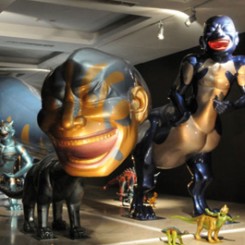Part I – A Thousand Smiles
Now for a few necessary words about a smile, specifically a man’s smile…the smile of the scholars who had accepted Diotima’s invitation and were listening to the famous artists. Although they were smiling, they were absolutely not to be suspected of doing so ironically. (The Man without Qualities by Robert Musil)
Samuel Pepys wrote in his diary that he was “As happy a man as any in the world, for the whole world seems to smile upon me!” Perhaps this is the source of the more banal “smile and the whole world smiles with you.” Whereas the first acknowledges a comforting delusion–indicated by the use of the word ‘seems,’ the latter is more egotistically feel-good and thereby suckered by its own delusion. Pepys is ecstatic but he knows what that means. You see, he asks of us: what are you smiling at? And more importantly, what are they smiling at? What matters though is whether you get the joke.
There are many different smiles, not least of all in art. There is the tragicomic smile of the clown, the enigmatic smile of Mona Lisa or Picasso’s slashes, Tom Wesselmann’s porn-smile and Warhol’s gloss-smile. And you can think about these smiles endlessly because it’s never entirely clear what they mean, on whom the joke falls, who laughs last and who is hedging their bets smiling on the other side of their face. A smile is a pleasure but also a defense, stimulating and dissimulating.
In 1528, a year prior to his death in Spain where he was ambassador for the Pope, Baldassare Castiglione’s famous humanist book of instruction, “The Courtier,” was published. In it he developed the notion of sprezzatura or “studied nonchalance,” the air or grace that Castiglione believed a good courtier needed to maintain in order to serve his master–including the knowing smile. By this time he was the Pope’s ambassador to the Court of Spain and the Duke of Urbino had made him a count. Evidently his sprezzatura smile served him better than tongue-in-cheek irony did Machiavelli, who was forced into retirement by an unappreciative Lorenzo Medici, to whom Machiavelli’s infamous The Prince had been dedicated. Smiles can be tricky. It is their very uncertainty, however, that makes smiles such an attractive foil for art.
In his various writings on the European novel, Milan Kundera has stressed the importance of uncertainty. Uncertainty is not moral equivalence. The rhetorical power of ambiguity in a novel is consistently more affecting than didacticism. In his novels one could even speak of the presence of a narrator’s smile, wry, tragic, resigned but also subversive and funny. His first novel, The Joke, looks at how a trivial joke has unintended consequences, escaping the intentions of the joker and coming back to haunt him. As the joke is repeated, it loses its light charm and becomes something tyrannical, a golem (see) only in The Joke there is no magical Rabbi to make it go away.
This almost brings us to the smiling men of Yue Minjun. Remember first, though, that post-modernism is not simply what followed modernism but is defined by it. For Postmodernism, Modernism is an unreachable utopia. We might say Postmodernists are all romantics but not in the sense of wistful nostalgia, not a saccharine hankering after the good old days. Romanticism longs for an idolized beloved who was perhaps never possessed. Only a lover could make bitter jokes on the one hand and superficial ones on the other. Only a lover could combine respect and distaste, tenderness and ridicule. Now look at Yue Minjun’s smile, one which has become famous the world over. Again and again we see his lurid pink face with its huge, gaping smile – eyes squeezed shut, cheeks taut, lips, teeth, tongue, epiglottis! – a Loony Tunes smile. Not sexualized like Tom Wesselmann’s, not psychotic like Takashi Murakami’s but also not vacant like Warhol’s.
